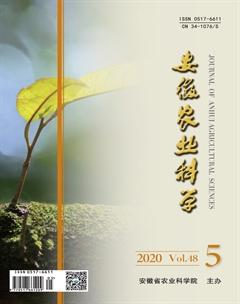森林凋落物分解过程对土壤微生物影响研究综述
骆娟
摘要 总结前人研究成果,选取了目前针对凋落物分解研究相对较多的几个方向进行总结,围绕凋落物组成、外源氮添加、季节和温度变化等常见因素在凋落物分解过程中对微生物群落的影响进行了比较分析,为未来进一步深入研究凋落物分解过程与土壤微生物互作关系提供理论依据。
关键词 森林凋落物;土壤微生物;环境因子
中图分类号 S714 文献标识码 A
文章编号 0517-6611(2020)05-0025-03
doi:10.3969/j.issn.0517-6611.2020.05.007
开放科学(资源服务)标识码(OSID):
Abstract Based on summing up the previous studies,this paper selected four common directions which are the litter composition,external nitrogen additions,seasonal and temperature variation to summarize and compare the effects on soil microbial community in litter decomposition,which provided theoretical basis for the further research of the interactions between litter decomposition and soil microorganisms.
Key words Forest litter;Soil microorganism;Influence factors
森林土壤为森林植物提供生长所需的营养物质和生长基质,同时森林植物在生长过程中又不断以凋落物形式把养分返还土壤,补充并改善土壤肥力及土质结构,促进森林生态系统的良性循环。森林凋落物是生态系统的重要组成部分,是森林地上、地下生态系统物质和能量流动的关键环节[1-4]。据统计,每年凋落物总量约占地球生物量的90%以上[5],森林植被通过凋落物形式分解并释放有机质和其他养分,促进养分返还土壤并提升林区土壤肥力水平,为维持森林生态系统的养分平衡和正常的物质循环发挥着重要功能[6-7]。因此,凋落物分解被认为是森林生态系统中碳、氮及其他养分循环的关键步骤。而土壤微生物在森林生态循环系统中承担着森林凋落物分解、促进养分转化与循环等功能[8]。森林凋落物分解过程的主要参与者是土壤微生物,有研究证明,土壤中微生物量的90%以上为细菌和真菌,它们在凋落物分解转化过程中发挥着主要作用,在凋落物分解过程中微生物把有机化合物等大分子物质分解为能够被植物吸收利用的小分子物质,对植物的生长以及土壤的形成与改良,甚至温室气体排放等方面发挥着积极作用[9-11],并影响和控制植被群落的演替和养分循环过程[12]。反过来,森林凋落物也为微生物提供了丰富的能量和营养物质来源,促进微生物群落生长繁殖[13]。因此,微生物在森林凋落物分解过程中的具体功能以及微生物群落特征与凋落物分解过程的关系等内容成为当前森林生态学领域研究的重点内容[14]。
1 凋落物多样性对微生物的影响
森林凋落物分解产物是土壤养分的主要来源,是森林土壤环境营养物质及碳循环的关键环节。作为主要的外源有机物,森林凋落物主要由糖类、淀粉、脂肪等易分解的成分和木质素、多酚、腐殖酸等难分解的成分组成[15],不同植物品种凋落物的组成成分及生物量也会存在差异。作为森林凋落物最主要的分解者,微生物群落多样性和数量与凋落物品质关系密切[16-18]。
植物群落结构和物种组成发生变化会导致凋落物基质数量和质量随之改變,进而影响微生物群落的变化,并进一步改变物质养分生态循环进程。大量相关研究已经证实凋落物数量和组成多样性的变化会对微生物群落产生显著影响,总结前人研究主要集中在凋落物类型对土壤微生物的数量、群落组成以及碳代谢等方面[19-25]。如宿晓琳等[26]分别对比了单个物种、两个物种、四个物种和八个物种等4种不同凋落物多样性组合分解过程中微生物群落的变化特征,结果显示凋落物多样性对土壤微生物群落的影响显著,特别是在生态系统演替初期凋落物理化指标能揭示微生物群落结构变异的12.3%。陈法霖等[25]也研究发现与单一针叶林相比,针叶、阔叶混合凋落物分解提高了土壤微生物群落碳代谢强度,通过改变凋落物组成能显著影响微生物群落的代谢多样性。而Waring等[27]对比了5种热带地区的植物凋落物分解试验,结果发现分解速率与叶片养分含量显著相关,凋落物组成直接影响到真菌群落组成。Bending等[28]研究认为树种特性和多样性能够对土壤微生物的群落结构产生关键影响,混合凋落物比单一凋落物含有类型更丰富多样的碳源和其他养分物质,更利于微生物繁殖及其多样性的增加,也有研究认为由于针叶林凋落物含有大量不易被分解的木质素和腐殖酸类物质,因此,土壤中以能够分解结构复杂的有机碳为主的微生物为主导,微生物类群较为单一[29]。而阔叶林中细菌丰度显著高于针叶林,如钟哲科等[20]对比杨树和水杉叶子的分解过程发现杨树叶子的分解速率及微生物数量显著高于水杉叶片。相关分析认为阔叶林凋落物在分解过程中引入土壤的碳含量和碳种类高于针叶林,直接导致了微生物类群的变化,因此,可以通过向针叶林凋落物中混入阔叶林凋落物来增加土壤微生物量并增加土壤微生物碳代谢强度。陈法霖等[25]认为凋落物混合后改变了有机物元素的组成结构,如碳氮比、木质素与氮磷比等,进而影响微生物碳代谢的多样性。
凋落物的多样性与土壤微生物多样性呈正相关关系,不同凋落物混合后会产生交互作用,导致其分解速率增加或减慢,应通过合理控制凋落物碳氮比来调控其分解速率[30-31]。林开敏等[32]通过对杉木及其伴生植物混合后分解情况进行研究,发现凋落物混合后分解会发生交互影响,营养含量较高的凋落物分解过程中会促进养分含量较低的凋落物的分解,凋落物混合并利于促进碳氮循环的速率与分解速度[33]。然而也有研究者有不同意见,王春阳等[34]对比了黄土区6种植物凋落物分解过程认为多种枯落物混合后土壤微生物碳、氮含量及比值并为发生显著变化,其原因可能与不同凋落物化学组成的差异性相关[35]。因为混合凋落物的植物种类、数量和比例不同,分解物之间会发生或协同、或拮抗等作用,导致分解速率发生变化。不同类型凋落物混合后也会引起微生境的改变,进而引起微生物活性和多样性的变化[22,36-40]。
[2]MAGUIRE D A.Branch mortality and potential litterfall from Douglasfir trees in stands of varying density[J]. Forest ecology & management,1994,70(1/2/3):41-53.
[3]WITKAMP M.Microbial populations of leaf litter in relation to environmental conditions and decomposition[J]. Ecology,1963,44(2):370-377.
[4]WARDLE A D.Ecological linkages between aboveground and belowground biota[J]. Science,2004,304(5677):1629-1633.
[5]CEBRIAN J.Patterns in the fate of production in plant communities[J]. American naturalist,1999,154(4):449-468.
[6]刘颖,韩士杰,林鹿.长白山四种森林类型凋落物动态特征[J].生态学杂志,2009,28(1):7-11.
[7]薛立,何跃君,屈明,等.华南典型人工林凋落物的持水特性[J].植物生态学报,2005,29(3):415-421.
[8]周建斌,陈竹君,李生秀.土壤微生物量氮含量、矿化特性及其供氮作用[J].生态学报,2001,21(10):1718-1725.
[9]POTTHOFF M,DYCKMANS J,FLESSA H,et al.Decomposition of maize residues after manipulation of colonization and its contribution to the soil microbial biomass[J].Biology & fertility of soils,2008,44(6):891-895.
[10]许湘琴,林植华,陈慧丽.凋落物分解对土壤生物的影响[J].生态学杂志,2011,30(6):1258-1264.
[11]CROWTHER T W,STANTON D W G,THOMAS S M,et al.Topdown control of soil fungal community composition by a globally distributed keystone consumer[J].Ecology,2013,94(11):2518-2528.
[12]BERG B,LASKOWSKI R.Decomposers:Soil microorganisms and animals[J].Advances in ecological research,2005,38:73-100.
[13]NEVINS C J,NAKATSU C,ARMSTRONG S.Characterization of microbial community response to cover crop residue decomposition[J].Soil biology and biochemistry,2018,127:39-49.
[14]SCHEIBE A,STEFFENS C,SEVEN J,et al.Effects of tree identity dominate over tree diversity on the soil microbial community structure[J].Soil biology & biochemistry,2015,81:219-227.
[15]強学彩,袁红莉,高旺盛.秸秆还田量对土壤CO2释放和土壤微生物量的影响[J].应用生态学报,2004,15(3):469-472.
[16]CRIQUET S,FERRE E,FARNET A M,et al.Annual dynamics of phosphatase activities in an evergreen oak litter:Influence of biotic and abiotic factors[J].Soil biology & biochemistry,2004,36(7):1111-1118.
[17]季晓燕,江洪,洪江华,等.模拟酸雨对亚热带三个树种凋落叶分解速率及分解酶活性的影响[J].环境科学学报,2013,33(7):2027-2035.
[18]KUBARTOV A,MOUKOUMI J,BGUIRISTAIN T,et al.Microbial diversity during cellulose decomposition in different forest stands:I. Microbial communities and environmental conditions[J].Microbial ecology,2007,54(3):393-405.
[19]李茜.黄土高原不同树种枯落叶混合分解对土壤性质的影响[D].杨凌:西北农林科技大学,2013.
[20]钟哲科,高智慧.杨树、水杉林带枯落物对土壤微生物C、N的影响[J].林业科学,2003,39(2):153-157.
[21]王春阳,周建斌,夏志敏,等.黄土高原区不同植物凋落物搭配对土壤微生物量碳、氮的影响[J].生态学报,2011,31(8):2139-2147.
[22]胡亞林,汪思龙,黄宇,等.凋落物化学组成对土壤微生物学性状及土壤酶活性的影响[J].生态学报,2005,25(10):2662-2668.
[23]彭琳.改变凋落物的输入方式对慈竹林土壤有机碳和酶活性的影响[D].雅安:四川农业大学,2012.
[24]王锐萍,刘强,彭少麟,等.尖峰岭不同树种枯落物分解过程中微生物动态[J].浙江林学院学报,2006,23(3):255-258.
[25]陈法霖,郑华,阳柏苏,等.中亚热带几种针、阔叶树种凋落物混合分解对土壤微生物群落碳代谢多样性的影响[J].生态学报,2011,31(11):3027-3035.
[26]宿晓琳,李英滨,杨波,等.植物多样性对亚热带森林土壤微生物群落的影响[J].生态学杂志,2018,37(8):2254-2261.
[27]WARING G B.Exploring relationships between enzyme activities and leaf litter decomposition in a wet tropical forest[J].Soil biology & biochemistry,2013,64(9):89-95.
[28]BENDING G D,TURNER M K,JONES J E.Interactions between crop residue and soil organic matter quality and the functional diversity of soil microbial communities[J].Soil biology & biochemistry,2002,34(8):1073-1082.
[29]SWIFT M J,HEAL O W,ANDERSON J M.Decomposition in terrestrial ecosystems[J].Studies in ecology,1979,5(14):2772-2774.
[30]BLAIR J M,PARMELEE R W,BEARE M H.Decay rates,nitrogen fluxes,and decomposer communiies of singleand mixedspecies foliar litter[J].Ecology,1990,71(5):1976-1985.
[31]BRIONES M J I,INESON P.Decomposition of eucalyptus leaves in litter mixtures[J].Soil biology & biochemistry,1996,28(10/11):1381-1388.
[32]林开敏,洪伟,俞新妥,等.杉木与伴生植物凋落物混合分解的相互作用研究[J].应用生态学报,2001,12(3):321-325.
[33]HANDA I T,AERTS R,BERENDSE F,et al.Consequences of biodiversity loss for litter decomposition across biomes[J].Nature,2014,509(7499):218-221.
[34]王春阳,周建斌,董燕婕,等.黄土区六种植物凋落物与不同形态氮素对土壤微生物量碳氮含量的影响[J].生态学报,2010,30(24):7092-7100.
[35]WRIGHT M S,COVICH A P.Relative importance of bacteria and fungi in a tropical headwater stream:Leaf decomposition and invertebrate feeding preference[J].Microbial ecology,2005,49(4):536-546.
[36]GE X G,ZENG L X,XIAO W F,et al.Effect of litter substrate quality and soil nutrients on forest litter decomposition:A review[J].Acta ecologica sinica,2013,33(2):102-108.
[37]陈法霖,郑华,欧阳志云,等.土壤微生物群落结构对凋落物组成变化的响应[J].土壤学报,2011,48(3):603-611.
[38]HATTENSCHWILER S,TIUNOV A V,SCHEU S.Biodiversity and litter decomposition in terrestrial ecosystems[J].Annual review of ecology evolution & systematics,2005,36:191-218.
[39]KUBARTOV A,RANGER J,BERTHELIN J,et al.Diversity and decomposing ability of saprophytic fungi from temperate forest litter[J].Microbial ecology,2009,58(1):98-107.
[40]WARDLE D A,NILSSON M C,ZACKRISSON O,et al.Determinants of litter mixing effects in a Swedish boreal forest[J].Soil biology & biochemistry,2003,35(6):827-835.
[41]宋蒙亞,李忠佩,刘明,等.不同林地凋落物组合对土壤速效养分和微生物群落功能多样性的影响[J].生态学杂志,2014,33(9):2454-2461.
[42]毛佳,徐仁扣,黎星辉.氮形态转化对豆科植物物料改良茶园土壤酸度的影响[J].生态与农村环境学报,2009,25(4):42-45,99.
[43]陈冬梅,柯文辉,陈兰兰,等.连作对白肋烟根际土壤细菌群落多样性的影响[J].应用生态学报,2010,21(7):1751-1758.
[44]GALLOWAY J N,TOWNSEND A R,ERISMAN J W,et al.Transformation of the nitrogen cycle:Recent trends,questions,and potential solutions[J].Science,2008,320(5878):889-892.
[45]STRENGBOM J,WALHEIM M,NSHOLM T,et al.Regional differences in the occurrence of understorey species reflect nitrogen deposition in swedish forests[J].Ambio,2003,32(2):91-97.
[46]SAIYACORK K R,SINSABAUGH R L,ZAK D R.The effects of long term nitrogen deposition on extracellular enzyme activity in an Acer saccharum forest soil[J].Soil biology & biochemistry,2002,34(9):1309-1315.
[47]COMPTON J E,WATRUD L S,PORTEOUS L A,et al.Response of soil microbial biomass and community composition to chronic nitrogen additions at Harvard forest[J].Forest ecology & management,2004,196(1):143-158.
[48]CUSACK D F,SILVER W L,TORN M S,et al.Changes in microbial community characteristics and soil organic matter with nitrogen additions in two tropical forests[J].Ecology,2011,92(3):621-632.
[49]袁颖红,樊后保,王强,等.模拟氮沉降对杉木人工林土壤有效养分的影响[J].浙江农林大学学报,2007,24(4):437-444.
[50]刘蔚秋,刘滨扬,王江,等.不同环境条件下土壤微生物对模拟大气氮沉降的响应[J].生态学报,2010,30(7):1691-1698.
[51]赵超,张文文,徐长柏,等.模拟氮沉降对杨树人工林土壤微生物群落结构的影响[J].生态学杂志,2015,34(2):360-366.
[52]FREY S D,KNORR M,PARRENT J L,et al.Chronic nitrogen enrichment affects the structure and function of the soil microbial community in temperate hardwood and pine forests[J].Forest ecology & management,2004,196(1):159-171.
[53]刘爽,王传宽.五种温带森林土壤微生物生物量碳氮的时空格局[J].生态学报,2010,30(12):3135-3143.
[54]刘纯,刘延坤,金光泽.小兴安岭6种森林类型土壤微生物量的季节变化特征[J].生态学报,2014,34(2):451-459.
[55]EDWARDS K A,MCCULLOCH J,KERSHAW G P,et al.Soil microbial and nutrient dynamics in a wet Arctic sedge meadow in late winter and early spring[J].Soil biology & biochemistry,2010,38(9):2843-2851.
[56]EDWARDS K A,JEFFERIES R L.Interannual and seasonal dynamics of soil microbial biomass and nutrients in wet and dry lowArctic sedge meadows[J].Soil biology & biochemistry,2013,57(3):83-90.
[57]ALLISON S D,VITOUSEK P M.Extracellular enzyme activities and carbon chemistry as drivers of tropical plant litter decomposition[J].Biotropica,2010,36(3):285-296.
[58]DESLIPPE J R,HARTMANN M,SIMARD S W,et al.Longterm warming alters the composition of arctic soil microbial communities[J].FEMS Microbiology Ecology,2012,82(2):303-315.
[59]RINNAN R,MICHELSEN A,BTH E.Longterm warming of a subarctic heath decreases soil bacterial community growth but has no effects on its temperature adaptation[J].Applied soil ecology,2011,47(3):217-220.
[60]BRADFORD M A,DAVIES C A,FREY S D,et al.Thermal adaptation of soil microbial respiration to elevated temperature[J].Ecology letters,2010,11(12):1316-1327.
[61] PETTERSSON M,BTH E.Temperaturedependent changes in the soil bacterial community in limed and unlimed soil[J].FEMS Microbiology Ecology,2003,45(1):13-21.
[62] 鄭海峰,陈亚梅,杨林,等.高山林线土壤微生物群落结构对模拟增温的响应[J].应用生态学报 2017,28(9):2840-2848.
[63] RINNAN R,MICHELSEN A,BTH E,et al.Mineralization and carbon turnover in subarctic heath soil as affected by warming and additional litter[J].Soil biology & biochemistry,2007,39(12):3014-3023.
[64] RINNAN R,MICHELSEN A,BTH E,et al.Fifteen years of climate change manipulations alter soil microbial communities in a subarctic heath ecosystem[J].Global change biology,2010,13(1):28-39.
[65] VAN MEETEREN M J M,TIETEMA A,VAN LOON E E,et al.Microbial dynamics and litter decomposition under a changed climate in a dutch heathland[J].Applied soil ecology,2008,38(2):119-127.
[66] INUBUSHI K,CHENG W,MIZUNO T,et al.Microbial biomass carbon and methane oxidation influenced by rice cultivars and elevated CO2 in a Japanese paddy soil[J].European journal of soil science,2011,62(1):69-73.
[67] GUTKNECHT J L M.Exploring longterm microbial responses to simulated global change[D].Madison:University of WisconsinMadison,2007.
[68] RINNAN R,STARK S,TOLVANEN A.Responses of vegetation and soil microbial communities to warming and simulated herbivory in a subarctic heath[J].Journal of ecology,2009,97(4):788-800.
[69] SCHIMEL J,BALSER TC,WALLENSTEIN M.Microbial stressresponse physiology and its implications for ecosystem function[J].Ecology,2007,88(6):1386-1394.
[70] HYVNEN R,GREN G I,DALIAS P.Analysing temperature response of decomposition of organic matter[J].Global change biology,2010,11(5):770-778.

